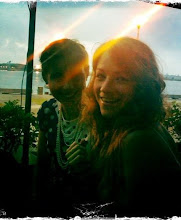It's also some of the most fun you can have with a class. Puns, comedic similes, malapropisms, double entendre, euphemisms...Oh, the joy that can be had!
One of my biggest personal challenges has been engaging the students with relevant humour. I mean, these kids have the same sense of humour I do. They love slapstick, parody and satire. They watch television shows that operate in these genre every night. The Simpsons, The Chaser, Summer Heights High, Kath and Kim, The Colbert Report and so on.
In an educational setting, the struggle with teaching humour is keeping it 'appropriate'.
You can't watch The Chaser skit that satirises A Current Affair, because it mentions 'fat kids'.
I can't show Summer Heights High because "puck you, miss" sounds a little too much like that other nasty phrase.
Now, don't get me wrong. I completely agree that we need to be mindful of 'inappropriate' material in the educational setting. But I don't know if completely avoiding it does any good for kids as they navigate through the 'real world'.
I'm pretty sure that a structured and monitored examination of how A Current Affair sensationalises weight issues might enable kids to be more critical of the 'news' being blasted at them every evening.
I'm lucky enough to be in a professional environment that encourages individual teacher developement. My ideas are met with open minds. Some are shot down. But that's probably a good thing. After all, I don't have the experience to say whether, in the long run, somthing will be a great idea or not.
In honour of my open-minded faculty and inspiring co-workers, here is the lesson I'm presenting to Year 8 English during Period 3 today.
After progressing from simple parody (in our last few lessons using 'Gangster's Paradise' by Coolio and 'Amish Paradise' by Weird Al Yankovich), we will discuss the concept of Satire.
First, show the following video clip. There is an accompanying worksheet at the bottom of the post.
Next, show the following video.
Students will be working in pairs to complete the Simpsons portion of the worksheet.
Then, we'll be viewing something a little more serious. But still funny.
Again, this will be contrasted with the following video clip from The Chaser's CNNNN.
During these videos, which may be played more than once (depending on how quickly students grasp what is actually going on), students work with their partners to answer the questions on the following worksheet.
I'm not claiming any of this is really revolutionary. I know I'm not using technology that will blow peoples' minds. Or even wow them a little. I just want a place to vent about my creative processes!








